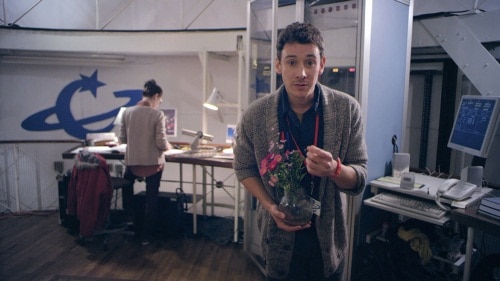
Still from the upcoming short film The Theory of Everything. (Courtesy: Catsnake)
By Matin Durrani
The e-mail arrived out of the blue last week. Did I want to attend a “private screening” in Covent Garden, London, of a new short film about cosmology, particle physics and love?
It sounded interesting, particularly when writer/producer Stephen Follows from Catsnake said that he had made the film with “some of the world’s leading dark-matter physicists, both at Imperial College and at CERN”.
I was even more intrigued when Follows added that the film had been funded by the Lovestruck dating agency as a promotional tool – apparently, the company was happy for him to make any film he liked, so long as it featured love somewhere along the line.
Follows took for inspiration the book The 4% Universe by the US science writer Richard Panek, which he had just been reading and which incidentally was second in Physics World‘s top 10 books of 2011. The title refers to the fact that “normal” matter makes up only 4% of the universe – the rest being dark matter (23%) and dark energy (73%).
What intrigued me was how exactly love could be brought into a story about cosmology.
Entitled The Theory of Everything, the film will be released online in early December so I won’t spoil the plot, such as it is. But suffice to say, the five-minute professionally produced film draws a parallel between the search for love and the search for dark matter. You know both are there even if you can’t see either for real. Love affects everyone just as dark matter and dark energy affect the universe.
If you think that sounds cheesy, well it could have been – in the wrong hands – but I was impressed with the film. It packs in a surprising amount of “real” science, which was accurate too, thanks to Imperial cosmologist Roberto Trotta, who acted as informal script adviser.
Visually, I liked the way the film tried to explain the expanding universe through the main character – an astronomer – dropping a jar of chocolate Smarties onto a table and showing them scatter in all directions. There’s also a nice touch where he uses the stem of a bunch of flowers as a measuring stick, snipping off the final 4% of the tip to illustrate just how small a fraction of the universe we really understand.
Both Follows and Trotta hope the film, which was made at an observatory in Mill Hill, London, reveals the human side of science. As Trotta told the audience before the screening, “There’s so much more to science and to creativity in science than meets the eye.”
Follows envisages the film being just the first in a series of projects carried out in partnership with Imperial. It will be released on YouTube and promoted on the London Underground and Facebook.
If you want some cosmic action before then, do check out our own film about a group of students trying to detect cosmic rays on a hot-air balloon.



